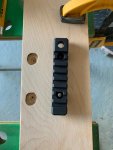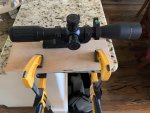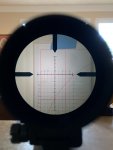I wanted to check the tracking on a few scopes I have, but didn't have an opportunity to make it to the range... So I decided to try tracking them against a wall in my living room. I'm sure I'm not the first to do this, but I did a quick search and I didn't see any info about doing this anywhere else. So I figured I would share it here, and risk the criticism.
I made a simple mount with a piece of plywood and a section of pic rail, attached a scope mount to it, put a scope in it, and clamped it to a counter top in the kitchen. Then I measured the distance to the wall and did the math to find out the vertical distance that corresponded to 1mil. Then I used a set of digital calipers to plot out a grid, taped it to the wall, and I was able to check tracking in my living room.
So before I get crucified for not doing a real tall target test on the range, I offer these points:
So I'd like to hear opinions on this method, and what's good and bad about it. I think if you're careful it's a perfectly legit way to check tracking, since it's looking at the scope's mechanics and takes that variable of firing rounds out of the equation. What am I overlooking?
I made a simple mount with a piece of plywood and a section of pic rail, attached a scope mount to it, put a scope in it, and clamped it to a counter top in the kitchen. Then I measured the distance to the wall and did the math to find out the vertical distance that corresponded to 1mil. Then I used a set of digital calipers to plot out a grid, taped it to the wall, and I was able to check tracking in my living room.
So before I get crucified for not doing a real tall target test on the range, I offer these points:
- My grid isn't perfect, but based on 0.1 mil clicks they're good to about half of that, or 0.05 mils. And the pencil lines are thin enough that they are about the same, 0.05 mils. So it's easy to see very small alignment issues.
- Conversely, when you shoot a tall target test at 100 yards you are dealing with bigger variables... Wind and atmospheric conditions are factors, but even if you dial those out with a solid zero at 100 yards, the group measurement itself is a variable. If you shoot 1" groups at 100 Yards, that's a spread of 0.28 mils, or 0.14 to the center of the group. How many shots do you fire? What about "fliers" being included or excluded?
- What I'm seeing is that you can do the math and draw the grid tighter than you can shoot 1" groups, even 1/2" groups. And checking the tracking on my scope I could easily see the reticle move each 0.1 mil.
So I'd like to hear opinions on this method, and what's good and bad about it. I think if you're careful it's a perfectly legit way to check tracking, since it's looking at the scope's mechanics and takes that variable of firing rounds out of the equation. What am I overlooking?



